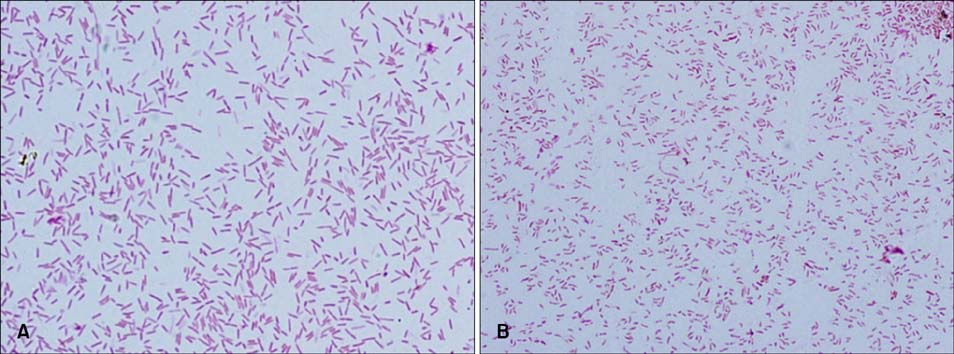Ann Dermatol.
2011 Sep;23(Suppl 1):S25-S29. 10.5021/ad.2011.23.S1.S25.
Aeromonas hydrophila Sepsis Mimicking Vibrio vulnificus Infection
- Affiliations
-
- 1Department of Dermatology, Wonkwang University School of Medicine, Iksan, Korea. sdpark@wonkwang.ac.kr
- 2Institute of Wonkwang Medical Science, Wonkwang University School of Medicine, Iksan, Korea.
- KMID: 2156744
- DOI: http://doi.org/10.5021/ad.2011.23.S1.S25
Abstract
- Aeromonas hydrophila is a facultatively anaerobic, asporogenous gram-negative rod that has often been regarded as an opportunistic pathogen in hosts with impairment of a local or general defense mechanism. A 68-year-old alcoholic woman presented with shock and gangrene on the right arm. At first, her clinical presentations were severe painful erythematous swelling that worsened within a few hours with development of gangrene, edema, and blisters. Bullous fluid and blood cultures yielded A. hydrophila. Histopathological findings of sections obtained from the vesicle revealed subepidermal vesicles; necrosis of the epidermis, papillary dermis, and subcutaneous fat; and massive hemorrhage in the subcutis. Despite all efforts to save the patient, she died 8 hours after admission. Clinical features of A. hydrophila sepsis resemble those of Vibrio vulnificus sepsis. Therefore, in addition to the case report, we compared the cultural, biochemical, and morphological differences between A. hydrophila and V. vulnificus for facilitation of early and accurate identification of the causative agent.
MeSH Terms
Figure
Reference
-
1. Abbott SL. Murray PR, Baron EJ, Jorgensen JH, Pfaller MA, Yolken RH, editors. Aeromonas. Manual of clinical microbiology. 2003. 8th ed. Washington DC: ASM Press;701–705.2. Davis WA 2nd, Kane JG, Garagusi VF. Human Aeromonas infections: a review of the literature and a case report of endocarditis. Medicine (Baltimore). 1978. 57:267–277.3. Janda JM, Abbott SL. The genus Aeromonas: taxonomy, pathogenicity, and infection. Clin Microbiol Rev. 2010. 23:35–73.
Article4. Park SD, Lee JY, Kim HD, Yoon NH. Clinical study of vibrio vulnificus sepsis. Korean J Dermatol. 2006. 44:696–707.5. McCracken AW, Barkley R. Isolation of Aeromonas species from clinical sources. J Clin Pathol. 1972. 25:970–975.
Article6. Trust TJ, Chipman DC. Clinical involvement of Aeromonas hydrophila. Can Med Assoc J. 1979. 120:942–946.7. Thelestam M, Ljungh A. Membrane-damaging and cytotoxic effects on human fibroblasts of alpha- and beta-hemolysins from Aeromonas hydrophila. Infect Immun. 1981. 34:949–956.
Article8. Brenden RA, Huizinga HW. Pathophysiology of experimental Aeromonas hydrophila infection in mice. J Med Microbiol. 1986. 21:311–317.
Article9. Trakhna F, Harf-Monteil C, Abdelnour A, Maaroufi A, Gadonna-Widehem P. Rapid Aeromonas hydrophila identification by TaqMan PCR assay: comparison with a phenotypic method. Lett Appl Microbiol. 2009. 49:186–190.
Article10. Von Graevenitz A, Mensch AH. The genus Aeromonas in human bacteriology report of 30 cases and review of the literature. N Engl J Med. 1968. 278:245–249.11. Kang JM, Kim BN, Choi SH, Kim NJ, Woo JH, Ryu JS, et al. Clinical features and prognostic factors of Aeromonas bacteremia. Infect Chemother. 2005. 37:161–166.12. Ha BS, Won YH, Chun IK, Kim YP. Haemorrhagic gangrene of skin caused by Aeromonas hydrophila. Ann Dermatol. 1989. 1:98–101.
Article13. Park HJ, Kim HY, Uh Y, Kwon OG, Oh JR. A case of Aeromonas hydrophila necrotizing fasciitis in patient on hemodialysis. Infect Chemother. 2007. 39:218–221.14. Ketover BP, Young LS, Armstrong D. Septicemia due to Aeromonas hydrophila: clinical and immunologic aspects. J Infect Dis. 1973. 127:284–290.
Article
- Full Text Links
- Actions
-
Cited
- CITED
-
- Close
- Share
- Similar articles
-
- Haemorrhagic Gangrene of Skin Caused by Aeromonas hydrophila
- Effect of Hydrogen Ion Concentration on the Growth of Vibrio vulnificus
- Vibrio Vulnificus Sepsis
- Generalized Erythema Multiforme-like Eruption is the Novel Cutaneous Manifestation of Vibrio Vulnificus Septicemia
- A Case of Septicemia without Skin Lesion by Serovar O1 Type of Vibrio vulnificus Infection





